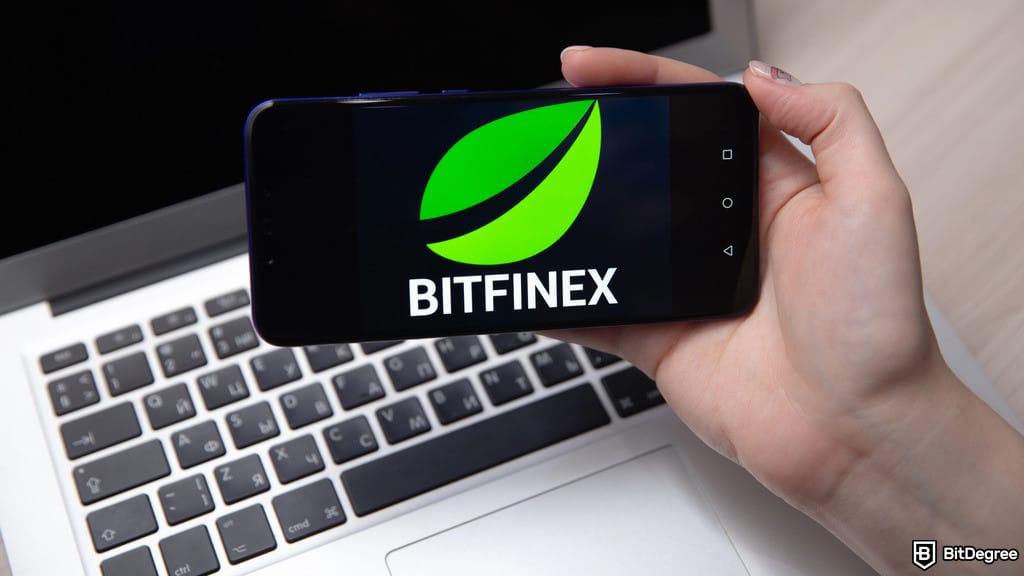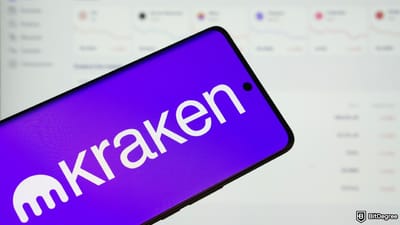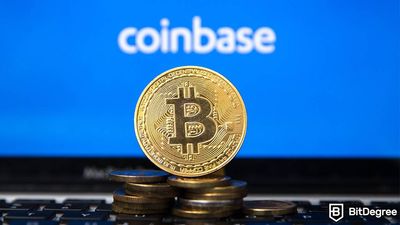Key Takeaways
- Crypto deposits are free on Bitfinex, while fiat deposits and crypto or fiat withdrawals depend on the asset and transfer method;
- Bitfinex uses a maker and taker fee system for spot and derivatives trading fees, while OTC fees depend on whether you’re placing an order through the desk or directly to/from another user;
- This exchange offers discounts for trading newly listed tokens, as well as lower fees for the LEO token holders and users with high trading volume.
Stop overpaying - start transferring money with Ogvio. Sign up, invite friends & grab Rewards now! 🎁
Nothing puts a downer on pulling off a perfect trade like being hit with surprise fees or finding out you’d had the wrong idea of withdrawal costs. If you’re just starting out on the Bitfinex exchange, don’t make the mistake of diving head-first without being crystal clear on how much you’ll be spending! Read this comprehensive Bitfinex fees guide first and find out exactly where your money will go.
Launched in 2012, Bitfinex is one of the oldest crypto trading platforms out there. Originally a peer-to-peer Bitcoin exchange, it gradually added support for other cryptocurrencies as they emerged, but as of writing this, it still holds the title of the world's second-largest exchange by number of Bitcoins held in its digital wallet (estimated at roughly 403,000 tokens).
Without further ado, let’s get started! Get to grips with the Bitfinex fees structure, learn all you need to know about the various discounts you can take advantage of, and compare how affordable this exchange is next to its top competitors, such as Binance, Kraken, and Bybit.

Did you know?
Subscribe - We publish new crypto explainer videos every week!
What is Blockchain? (Animated Examples + Explanation)


Table of Contents
- 1. Bitfinex Deposit & Withdrawal Fees
- 1.1. Verification Levels
- 1.2. Deposits
- 1.3. Withdrawals
- 1.4. Token Suspensions
- 2. Bitfinex Trading Fees
- 2.1. Trading Fee Discounts for Unus Sed LEO Holders
- 2.2. Trading Fee Discounts for Newly Listed Tokens
- 2.3. Spot Trading Fees
- 2.4. Derivatives Trading Fees
- 2.5. OTC Fees
- 3. Bitfinex Margin Funding Fees
- 4. Bitfinex Borrow Fees
- 5. Comparison With Other Crypto Exchanges
- 5.1. Bitfinex VS Binance
- 5.2. Bitfinex VS Kraken
- 5.3. Bitfinex VS Bybit
- 5.4. Bitfinex VS Coinbase
- 6. Conclusions
Bitfinex Deposit & Withdrawal Fees
One of the first types of Bitfinex fees you’ll probably come across is deposit and withdrawal fees. While there are a lot of similarities in how most centralized exchanges handle these, every platform is unique – so let’s see how much you’ll have to pay for moving fiat or crypto in and out of your account.
Latest Deal Active Right Now:Verification Levels
A little heads-up first, before we delve into the numbers: your KYC verification level will affect not only your deposit and withdrawal limits but the available transfer methods, too. Bitfinex has three levels of verification, each granting access to the following features:
Feature | Basic Plus | Intermediate | Full | |
|---|---|---|---|---|
Deposits | Crypto transfers | ✓ | ✓ | ✓ |
Stablecoin tokens | ✓ | ✓ | ✓ | |
International bank transfers | ✗ | ✗ | ✓ | |
SEPA (OpenPayd) | ✗ | ✓ | ✓ | |
On ramp (happyCOINS) | ✗ | ✓ | ✓ | |
Mercuryo | ✓ | ✓ | ✓ | |
Simplex | ✓ | ✓ | ✓ | |
OWNR Wallet | ✗ | ✓ | ✓ | |
Withdrawals | Crypto transfers | ✓ | ✓ | ✓ |
Stablecoin tokens | ✓ | ✓ | ✓ | |
International bank transfers | ✗ | ✗ | ✓ | |
SEPA (OpenPayd) | ✗ | ✓ | ✓ |
Table: Bitfinex KYC verification levels.
As you can see, with Basic Plus, you’d be pretty much stuck with only crypto deposits and withdrawals, with no options for sending or receiving fiat, so it’s definitely worth upgrading to Intermediate, at the very least. For that, you’ll need to provide:
- Second official photo identification;
- Proof of address;
- Financial questionnaire;
- KYC declaration.
And if you want to go all the way up to Full, you'll be asked to submit a bank statement on top of the abovementioned documents.
Deposits
When it comes to crypto deposits, there are no surprises: like other centralized exchanges, Bitfinex doesn’t charge anything for them. There’s no maximum limit on how much crypto you can deposit.
Fee | |
|---|---|
Crypto | Free |
Stablecoin | Free |
Securities | Free |
Bank Wire | 0.1% |
OpenPayd | 5 EUR/GBP per transaction |
Table: Bitfinex deposit fees.
As for fiat deposits, there are two types: a direct transfer from one bank account to another (wire), and a transfer through the OpenPayd platform. Wire transfers have a fee of 0.1%, with a minimum transfer of $100, and are available for USD, EUR, GBP, and JPY, while OpenPayd deposits cost 5 EUR or GBP per transaction and have no minimum or maximum withdrawal limit.
Last but not least, there’s one more type of deposit-related Bitfinex fees you hopefully won’t need, but should still be aware of. In case your tokens go missing during the transfer (e.g., because you provided the wrong wallet address or selected the wrong network), Bitfinex will charge you a $150 fee for the token recovery.
Only Basic Plus and above-verified users are eligible for the recovery process, and requests are only accepted for amounts exceeding $2,500.
Be aware that the recovery process might take weeks or even months, and there’s no guarantee you would get your tokens back, so make sure to avoid any typos and other mistakes when making cross-chain deposits!
Withdrawals
Bitfinex withdrawal fees apply to both crypto and fiat withdrawals, except when it’s an internal transfer; these are completely free of charge.
How much you’ll have to pay for withdrawing crypto depends on the token. Some tokens, like SUI, ATOM, DOT, DOGE, AVAX, and LEO (Bitfinex’s official token), have no withdrawal fees, while others have varying rates, depending on their network fees:
Fee | |
|---|---|
0.00006 BTC | |
0.00019624 ETH | |
Tether (on Solana) | 0.5 USDT/SOL |
Tether (on Ethereum) | 0.50609 USDT |
0.50615 USDC | |
0.005 SOL | |
0.3 ADA | |
0.1 XRP | |
0.001 LTC | |
1 TRX | |
35714 BONK | |
5636.3 FLOKI |
Table: Bitfinex crypto withdrawal fees.
The minimum amount of crypto you have to withdraw is the equivalent of $5.
And here are the fiat withdrawal fees:
Fee | |
|---|---|
Bank Wire | 0.1% (min 100 USD/EUR) |
Express Bank Wire (within 24 hours on business days) | 1% (min 125 USD/EUR) |
OpenPayd (for transfers of 10,000 EUR/GBP or less) | 5 EUR/GBP per transaction |
OpenPayd (for transfers of more than 10,000 EUR/GBP) | 0.1% of the transfer amount |
Table: Bitfinex fiat withdrawal fees.
The minimum withdrawal amount for OpenPayd is €/£25. For transfers below 10,000 EUR/GBP, you’ll be charged 5 EUR/GBP per transaction, while higher amounts cost 0.1%.
Token Suspensions
At this point, you know enough about the Bitfinex fees for withdrawals and deposits to get started, but there’s one more issue you might run into. Chances are, you won’t be able to transfer specific tokens to or from your account at certain times. As of July 11, 2025, deposits and withdrawals for the following tokens are suspended:
Tokens | |
|---|---|
Both Deposits and Withdrawals | ALT11M2507, ALT11M250830, TITAN1, TITAN2, USTBL |
Only Deposits | BLAST, CHEX, HMSTR, KMNO, NOT, SCROLL, XTP, TURBO, VELAR |
Only Withdrawals | USDT on Omni, Vaulta, Algorand, BCH, and USDTKSM, ZEC |
Table: Bitfinex-suspended tokens (as of July 11, 2025).
Keep in mind that these suspensions are only temporary and could change anytime, so don’t forget to regularly check Bitfinex’s website for the latest updates! Hover over [Traders] on the top menu bar and click [Deposits & Withdrawals] to see the full list.
Bitfinex Trading Fees
The Bitfinex exchange offers five types of crypto trading: spot, margin, derivatives, OTC, and demo. All except the last one come with their own specific fees. Like those of most other exchanges, Bitfinex trading fees follow the maker-taker model (where traders who place limit orders are charged lower fees as a reward for increasing liquidity[1]) and have a tiered structure based on the user’s trading volume.
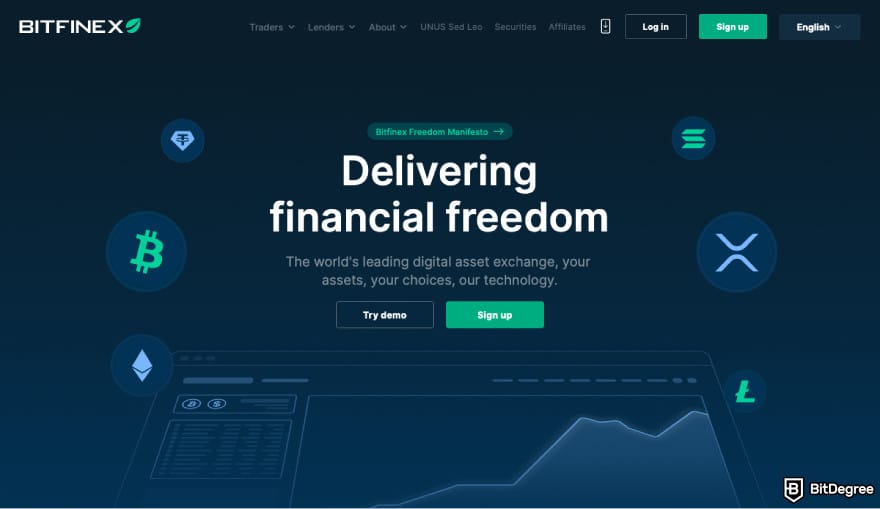
That said, if you don’t feel like poring over all these tables below, the Bitfinex website has a handy fee calculator that lets you input your trading volume and the amount of LEO tokens in your account and immediately see how much you’ll be charged for every trade. I’d definitely recommend using it to double-check your prospective fees just in case!

Did you know?
Subscribe - We publish new crypto explainer videos every week!
What is Litecoin? LTC Easily Explained (ANIMATED)
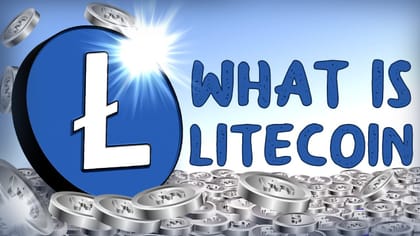

Trading Fee Discounts for Unus Sed LEO Holders
In line with some of the other popular exchanges like Binance, Bitfinex promotes its official token by giving its holders some additional perks – namely, trading fee discounts. The more Unus Sed LEO tokens you have, the lower your Bitfinex trading fees will be (especially for crypto-to-crypto and crypto-to-stablecoin trading pairs).
Unus Sed LEO trading discounts are only available for users with Intermediate or Full verification.
Here’s what the discount rates look like:
Requirement | Crypto-to-Crypto | Crypto-to-Stablecoin | Crypto-to-Fiat | Derivatives | |
|---|---|---|---|---|---|
Level 1 | > 1 USDT LEO equiv. | -15% (taker fees) | -15% (taker fees) | ✗ | ✗ |
Level 2 | > 5,000 USDT LEO equiv. | -25% (taker fees) | -25% (taker fees) | -10% (taker fees) | ✗ |
Level 3 | > 1,0000 USDT LEO equiv. | -25% + up to 6bps (taker fees) | -25% + up to 6bps (taker fees) | -10% + up to 6bps (taker fees) | -up to 0.5bps/1.5bps (maker/taker fees) |
Table: Bitfinex Unus Sed LEO discounts.
The good news is that the barrier of entry here is incredibly low: holding even as little as the equivalent of 1.5 USDT in Unus Sed LEO tokens will qualify you for a 15% discount for all spot crypto pairs!
It’s a pity that most of these discounts only apply to taker fees; although, as you’ll see below, Bitfinex fees for makers are already much lower as a way to incentivize more traders to place limit orders and add more liquidity to the exchange.
Trading Fee Discounts for Newly Listed Tokens
Being a new kid on the block is always hard, and cryptocurrencies are no exception. With how oversaturated the crypto landscape is at this point, new tokens often need all the help they can get to find their audience and increase their liquidity.[2]
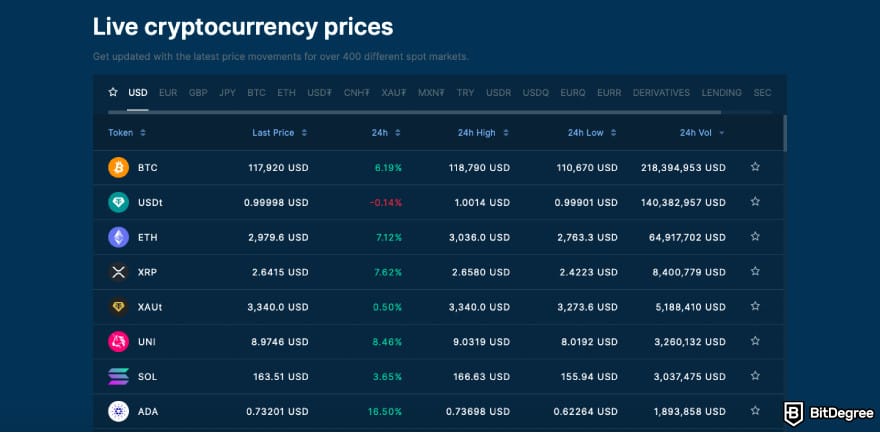
Which is why Bitfinex runs a promotional scheme to encourage users to give newly listed assets a chance by drastically reducing their trading fees. If you pick trading pairs with tokens that have been listed for less than 6 months, you’ll have to pay zero maker fees and a taker fee of only 0.04%.
To balance it all out, these tokens are exempt from the Unus Sed LEO holders’ discounts.
Since these discounts are limited-time, make sure to check the Bitfinex website to see which tokens still qualify as “newly listed”: hover over [Traders] on the top menu bar and click [Our fees], then scroll down to [New token listing trading fees discount].
Spot Trading Fees
When it comes to Bitfinex spot trading fees, the main thing you’ll need to pay attention to is your 30-day trading volume. Unlike some other top exchanges that have a more elaborate fee structure with named tiers, Bitfinex doesn’t have an official VIP program, but users with higher trading activity still get to enjoy discounted fee rates.
Here’s what they look like:
Maker Fee | Taker Fee | |
|---|---|---|
$0.00 - $500,000 | 0.100% | 0.200% |
> $500,000 | 0.080% | 0.200% |
> $1,000,000 | 0.060% | 0.200% |
> $2,500,000 | 0.040% | 0.200% |
> $5,000,000 | 0.020% | 0.200% |
> $7,500,000 | 0.000% | 0.200% |
> $10,000,000 | 0.000% | 0.180% |
> $15,000,000 | 0.000% | 0.160% |
> $20,000,000 | 0.000% | 0.140% |
> $25,000,000 | 0.000% | 0.120% |
> $30,000,000 | 0.000% | 0.100% |
> $300,000,000 | 0.000% | 0.090% |
> $1,000,000,000 | 0.000% | 0.085% |
> $3,000,000,000 | 0.000% | 0.075% |
> $10,000,000,000 | 0.000% | 0.060% |
> $30,000,000,000 | 0.000% | 0.055% |
Table: Bitfinex spot trading fees
The good news is that Bitfinex’s trading fee discounts all stack up: your final fee rate will be affected by both your trading volume and the amount of LEO tokens you hold.
Let’s say, for example, that you’ve traded $6 million in the past month. Based on that alone, your taker fee would be 0.2% – but you also happen to have 100 USDT’s worth of LEO tokens, which would make you eligible for an additional 15% discount and bring your final fee down to 0.17%.
Derivatives Trading Fees
Bitfinex fees for derivatives trading follow a similar pattern, the main difference being that the LEO token discount is only available to Level 3 holders (those with more than 10,000 USDT’s worth of tokens in their account). Here’s how much Bitfinex charges for derivatives:
Maker Fee | Taker Fee | |
|---|---|---|
$0.00 - $2,000,000 | 0.0200% | 0.0650% |
> $2,000,00 | 0.0125% | 0.0600% |
> $7,500,000 | 0.0100% | 0.0550% |
> $30,000,000 | -0.0025% | 0.0450% |
> $300,000,000 | -0.0050% | 0.0400% |
> $1,000,000,000 | -0.0075% | 0.0375% |
> $3,000,000,000 | -0.0100% | 0.0350% |
Table: Bitfinex derivatives trading fees.
There aren’t as many volume tiers as for spot trading, but the inclusion of maker fees in the LEO discounts partially makes up for it, and if your 30-day trading volume is above $30,000,000, you'll actually get a rebate instead of having to pay fees!
OTC Fees
Bitfinex offers two types of Over-the-Counter trading: OTC desk services (trades brokered by the exchange’s official OTC desk) and direct OTC trading (matching directly with other users).
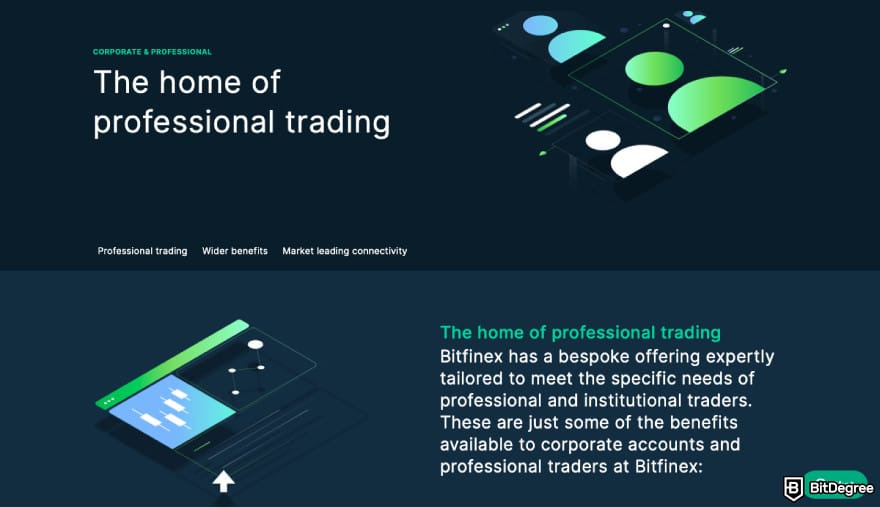
OTC desk trades have no fees at all, while trading directly with others costs 10 basis points (0.1%) per trade for both parties.
When it comes to limits, there’s no upper ceiling for the maximum amount you can trade over OTC, but the minimum amount for user-to-user OTC trades is $50, while the lowest amount you can trade over the desk is $100,000.
Bitfinex Margin Funding Fees
If you’re a fan of leverage trading, another type of Bitfinex fees you should read up on in advance is margin funding fees: the exchange’s cut of the interest rates a user earns by lending their crypto out for other margin traders.
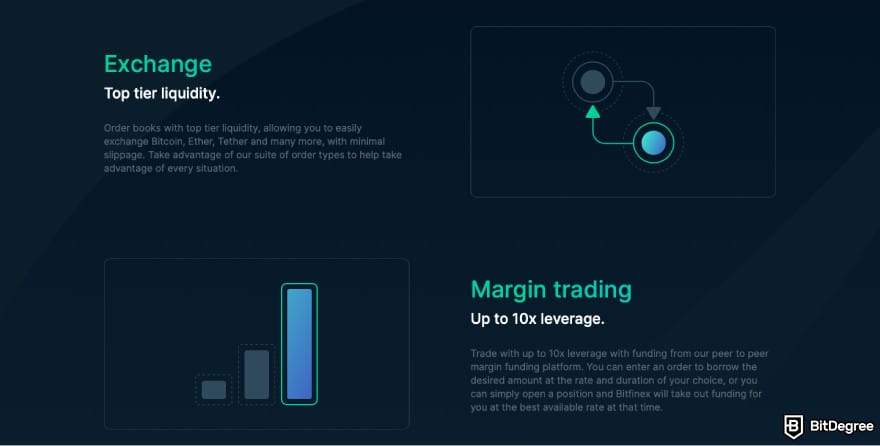
The regular funding rate on Bitfinex is 15% (that is, 15% of the lender’s profit earned in interest fees), except if the funding offer was placed using the hidden order option, in which case, the funding fee is 18%.
You’ll probably be wondering if there are discounts available for Unus Sed LEO token holders for margin lenders. Don’t worry – your LEO holdings will help you out here, too! Rather than a flat percentage-based discount, you’ll get a rebate of -0.05% for every 10,000 USDT in LEO tokens held in your account during the previous month (calculated on a daily basis).
This discount doesn’t apply to LEO-Vaulta and LEO-ERC20.
The LEO discount is capped at 5%.
Bitfinex Borrow Fees
If you’re the one who borrows funds on Bitfinex, you’ll have to pay interest for your crypto or fiat loan. Unlike most other exchanges that charge it on an hourly basis, Bitfinex has users pay interest in one-second increments – but only if your total borrowing time exceeds 1 hour.
Here’s how this works. Let’s say you’ve borrowed some crypto for a period of 2 hours. In this case, you’ll be charged for a total of 7,200 seconds. However, if you choose to borrow funds for only 30 minutes, you’d still be charged for a full hour. This rule functions as a safeguard to prevent users from exploiting the extremely low fee rates by only borrowing crypto for a very short time.
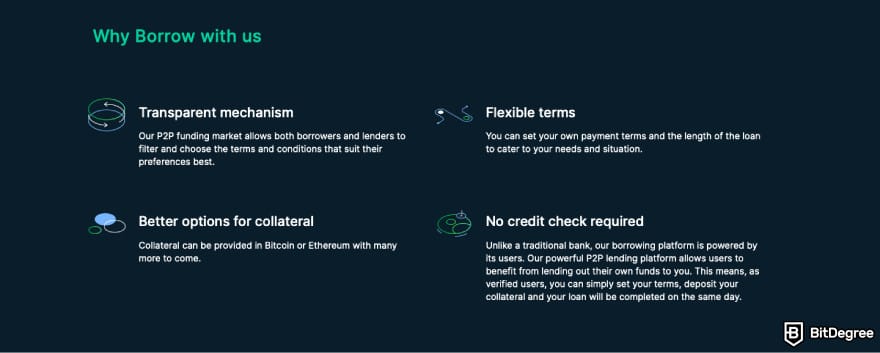
In place of margin position opening fees, Bitfinex charges a maker fee twice: when you deposit your collateral, and then again when you return the borrowed assets.
Finally, if Bitfinex takes over your margin position instead of liquidating it, you’ll be charged a fee of 0.5% of the loss you would have incurred if your position had been immediately liquidated at the time.
Comparison With Other Crypto Exchanges
Now that you have Bitfinex fees explained, you’re probably curious – where do they stand in comparison to other popular exchanges? Is trading on Bitfinex worth it cost-wise, or would you be better off with other alternatives? Time for the ultimate showdown of Bitfinex fees VS Coinbase, Binance, Kraken, and Bybit fees!
Bitfinex VS Binance
With over 272 million users worldwide, Binance is currently the biggest and most popular centralized crypto exchange in the world. It offers 400+ cryptocurrencies across 1,500+ market pairs and a whole arsenal of trading types for both beginners and pros: options, futures, margin, copy trading, and even a P2P marketplace.
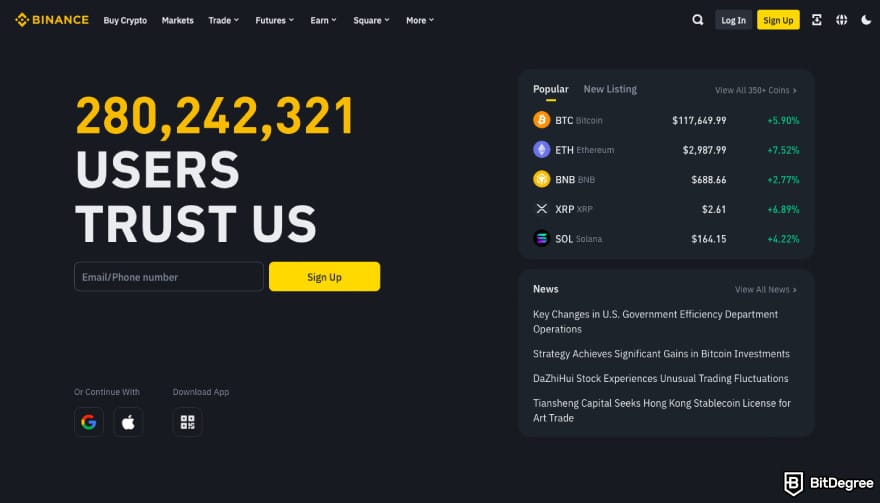
Much like Bitfinex, Binance has embraced both the tiered fee system and the official token discounts. Where it differs from our exchange in question is the execution: it offers 9 VIP levels, applicable to all types of trading, while Bitfinex boasts a whopping 15 tiers for spot trading, though only 6 for derivatives.
If you hold BNB (Binance’s official token), you’ll get to enjoy a 25% discount on spot trading fees and 10% off USDT-margined futures trading fees, as well as a 5% reduction on interest rates for crypto loans – which is on par or slightly more than offered by Bitfinex’s LEO token discounts, depending on the type of trading.
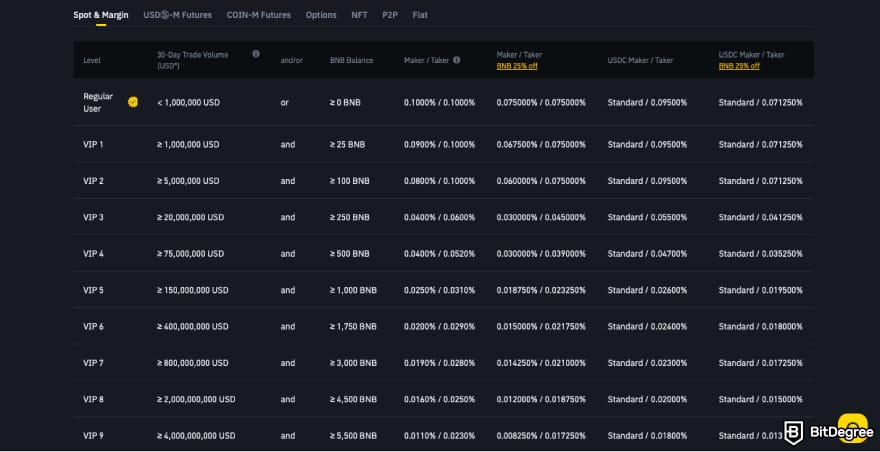
As far as the actual Bitfinex VS Binance fees comparison, Binance’s maker fee for non-VIP spot trading is the same as Bitfinex’s at 0.1%, but the taker fee is twice as low (0.1% versus 0.2% on Bitfinex). For derivatives and futures, these two exchanges are more evenly matched: both exchanges charge a maker fee of 0.2%. On the other hand, Binance slightly edges out Bitfinex in the taker fee department, with the former charging 0.05% and the latter 0.065%.
📚 Check Out: Binance Fees Breakdown
Bitfinex VS Kraken
Kraken has 15+ million users across 190+ countries. You’ll find ~420 cryptocurrencies and a variety of trading options like margin trading with up to 5x leverage, derivatives trading with 200+ multi-collateral contracts, a DeFi swapping platform, and an OTC trading desk.
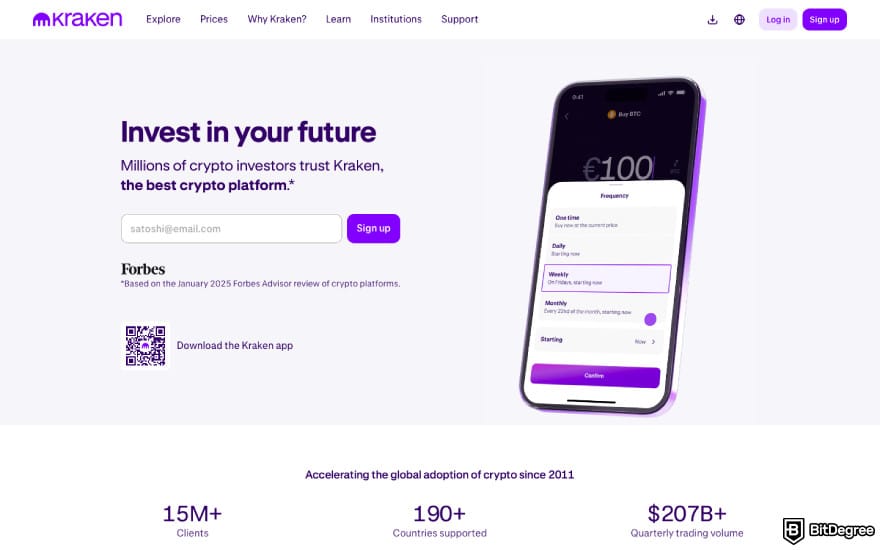
One of this exchange’s selling points that gives it a strong head start in the Bitfinex VS Kraken fees contest is its Kraken+ platform, which lets users trade crypto with zero trading fees (up to $10,000 per month) and offers a number of other rewards, such as exclusive airdrops. What’s more, you can get a free trial for 30 days, and after that, it costs only $4.99 a month.
Kraken splits its spot trading fees into separate categories based on asset types. There’s a 0.25%/0.4% maker/taker fee for crypto pairs, and a 0.2% maker/taker fee for fiat, stablecoin, or pegged token pairs (the last one applies to trading pairs like TBTC/BTC or WBTC/BTC). In short, Bitfinex is a clear winner in this case, with twice as low maker/taker fees.
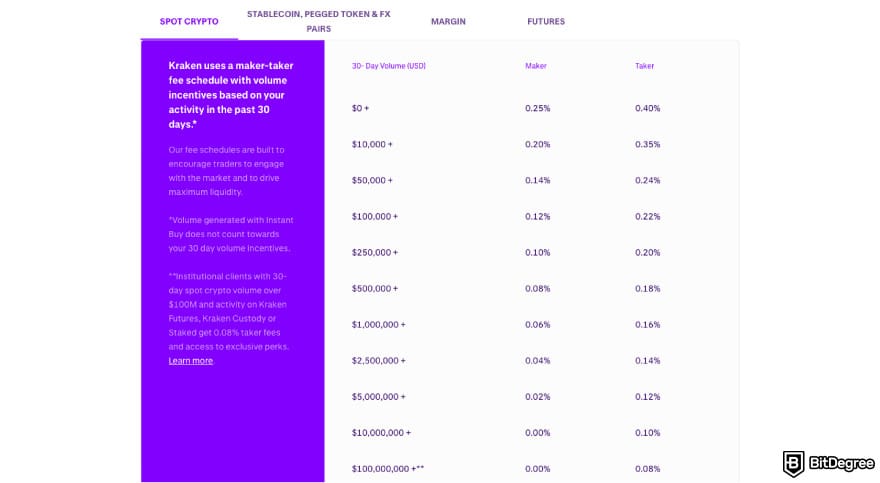
When it comes to futures fees, Kraken doesn’t differentiate between types of perpetual contracts. The universal futures fee is 0.02% for makers and 0.05% for takers, which is more or less on par with Bitfinex’s derivatives fees. Kraken also charges a 0.01% to 0.02% opening and maintenance fee for margined positions.
📚 Check Out: Kraken Fees: A Complete Guide
Bitfinex VS Bybit
Launched in 2018, Bybit might be among the younger A-list centralized exchanges, but it has long established itself as a worthwhile player. As of writing this, it has more than 60 million active users, almost 2,000 cryptocurrencies, and a considerable selection of trading options, such as margin, futures, options, spread trading, and pre-market trading.
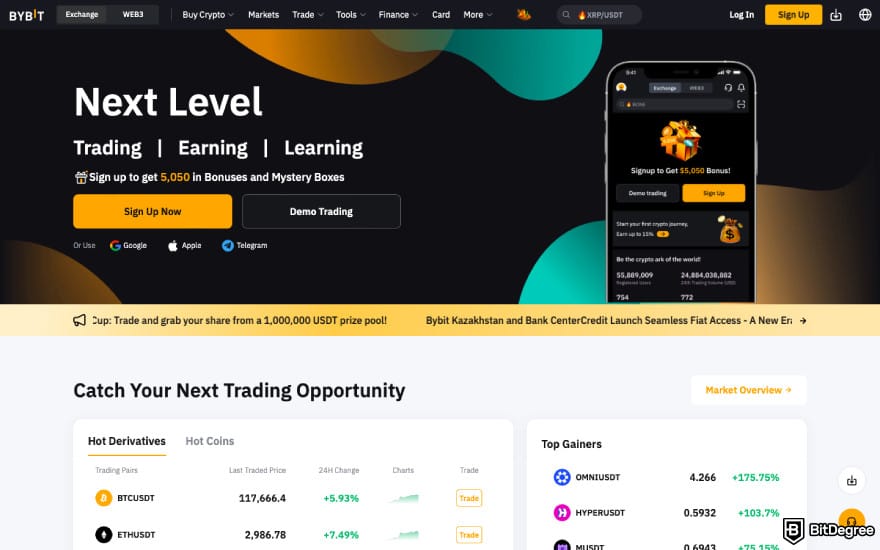
Like Bitfinex, Bybit has implemented a tiered fee structure: there are 6 VIP tiers and 6 additional Pro tiers, the latter category featuring inverse fees (or rebates) for futures trading. Which tier you’re on is determined by your 30-day trading volume, but there’s no option to get on the VIP system by holding the exchange’s official token, since Bybit doesn’t have one.
Speaking of the fees themselves, Bybit has the upper hand with taker fees for spot trading: both the taker and maker fees are 0.1% for non-VIP users, while Bitfinex charges 0.1% and 0.2%, respectively. Meanwhile, Bybit’s futures trading fees are 0.02% and 0.055% for makers and takers – once again, no difference in maker fees, but a better deal for takers than Bitfinex.
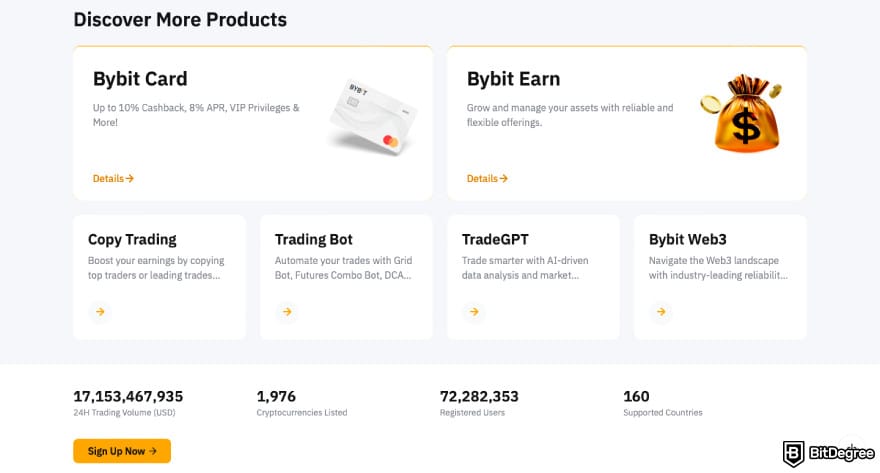
Bybit doesn’t charge any fees for crypto deposits, while fiat deposit and withdrawal fees vary based on the currency and payment method.
📚 Check Out: Bybit Fees Overview

- Secure and reliable
- Accepts fiat currencies
- Lots of trading options
- Reputable exchange
- Accepts fiat currencies
- Offers various trading options

- Huge trading variety
- Regulation-compliant around the globe
- Fair trading fees
- Beginner-friendly
- A wide array of features
- Vast number of different crypto coins & tokens

- Beginner-friendly
- Secure
- Decent trading and withdrawal fees
- Crypto.com Visa Card
- Automated tools & bots
- Ecosystem synergy with CRO
Bitfinex VS Coinbase
Founded in 2012 (the same year as Bitfinex), Coinbase is as much of a veteran in the crypto exchange scene as our platform in question. It boasts over 100 million users and 250+ cryptocurrencies, offering spot, margin, derivatives, and futures trading.
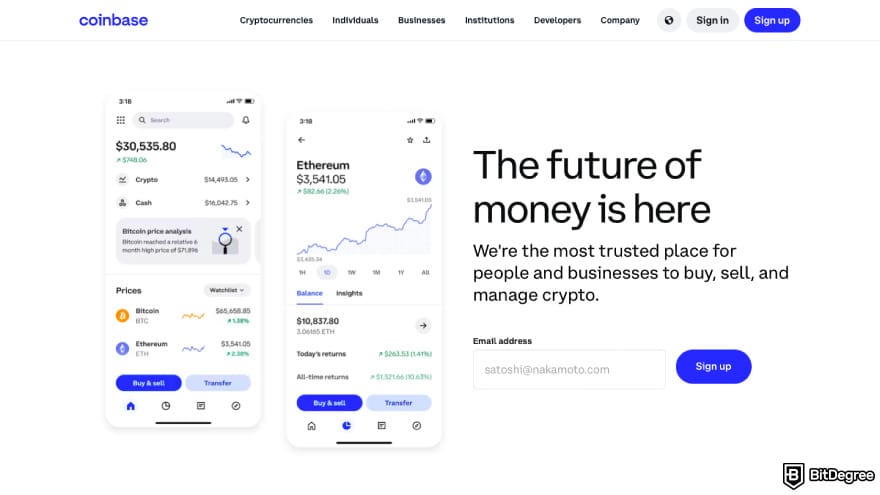
Just like Kraken, Coinbase offers a subscription service for trading crypto with zero fees, featuring a few additional perks like 24/7 priority support, enhanced account protection, and boosted USDC and staking rewards. Coinbase One costs $19.99 a month, but you can try it out for free for 7 days first.
As for the trading costs on the regular version of the exchange, in the contest of Bitfinex fees VS Coinbase fees, Bitfinex easily blows this competitor out of the water. Coinbase charges a 0.4% and 0.6% maker/taker spot trading fee for non-stablecoin crypto pairs, which is significantly pricier than most of the other popular exchanges.
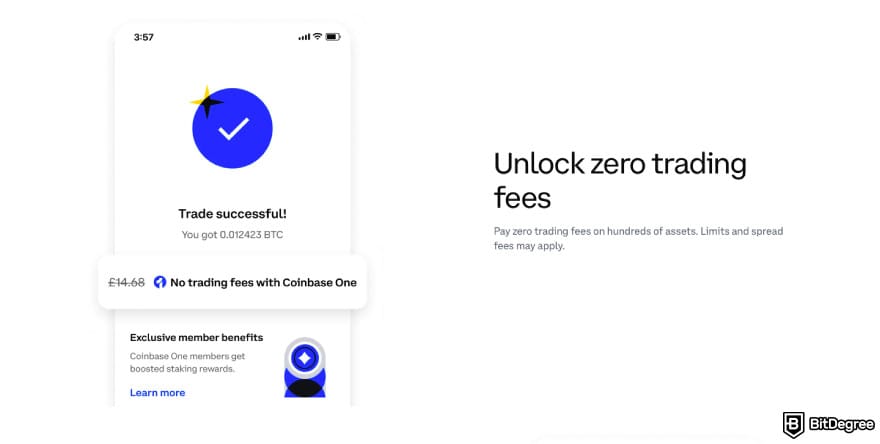
Unlike Bitfinex, Coinbase’s derivatives fees are charged at a fixed flat rate rather than a percentage-based model. They’re split into three main categories: market maker, non-professional (private users), and professional (businesses), and range from $0.07 to $0.75 depending on the cryptocurrency and category.
📚 Check Out: Coinbase Fees 2025
Conclusions
Hopefully, having Bitfinex fees explained like this paved the way for your smooth start on this exchange! All you need to do next time you’re trying to deposit or withdraw funds or place a trading order is check this guide again for a quick memo on how much you’ll be charged for any of those activities.
As a centralized exchange, Bitfinex doesn’t really stand out much with its fee structure: it employs a standard maker-taker trading fee structure with discounts for high-volume traders and holders of its official token, Unus Sed LEO. You won’t be charged for crypto deposits, but fiat deposits and both types of withdrawals have their own fees, depending on the currency and the method of transfer.
The content published on this website is not aimed to give any kind of financial, investment, trading, or any other form of advice. BitDegree.org does not endorse or suggest you to buy, sell or hold any kind of cryptocurrency. Before making financial investment decisions, do consult your financial advisor.
Scientific References
1. Brauneis A., Mestel R., Riordan R., Theissen E.: 'The anatomy of a fee change — evidence from cryptocurrency markets';
2. Ante, L.: 'Market Reaction to Exchange Listings of Cryptocurrencies'.
